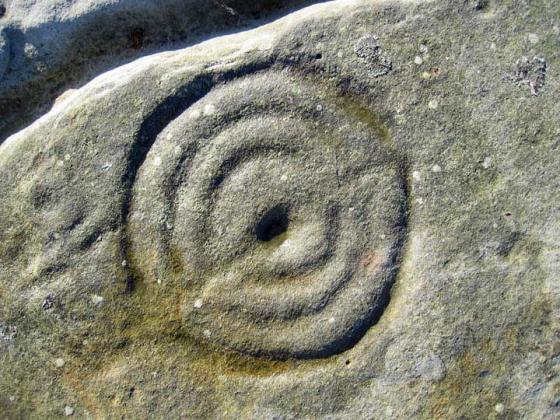
The Hurl Stone, looking roughly North-East

The Hurl Stone, looking roughly North-East

This shows the Hurl Stone with the Lilburn folly in the background


Many Apologies for the darkness of the photo, but I wanted to show the height of the stone and this was the best pic I had.
Moey Feb 2003CE

Feb 2003CE
Haven’t been able to find out any history of this one yet. It stands, set in a rough stone base, so may well be of modern origin, although it may be re(z)erected.
A tall thin stone, over 10ft tall, it leans or points quite heavily. Views over towards The Cheviots to the West and Hepburn Woods to the East.
Of notable mention is a bit of modern architecture just oevr the hill – The Hurlstone Tower was built in 2000 by the local landowner and is a round 3 storey castle looking folly.
An old bastile-house (Hebburn Castle or Tower, the old seat of the family of Hebburn) stands in the southern part of Chillingham Park, from which a concealed passage was said to have passed to a pillar-like stone, named the Horl-stone or Hurl-stone, in a field near the New Town of Chillingham or Chillingham Newton.
Hebburn Castle must be Hepburn Bastle, a 16th century tower house in Chillingham Park, which is a mile or two to the east, across the river.
Horl-stone is by some conjectured to be Earl’s Stone. It was erected in a socket by Mr. Jobson, late farmer of Chillingham Newton: and some years ago had a portion struck off it by lightning.
These quotes are from the Denham tracts, and you can read more from them about the connection between the Hurlstone and Cateran’s Hole on the latter’s page.
Among the traditions attaching to megaliths and boulders a very common one is that they have been hurled to their place by giants, and crosses have been added by giants to this sport. The famous Hurle Stone at Chillingham, much famed for its circumambulatory ritual expressed in the jingling rhyme:
“Wind about and turn again,
And thrice round the Hurl Stane.
Round about and wind again,
Thrice round the Hurl Stane”is actually a Christian cross. In this case the acquisition of the tradition may be due to the conformation of the shattered shaft which is pointed and inclines to the east, thus giving it “from a distance the look of a gigantic cross-bow bolt hurled here.“**
*Denham Tracts, ii, p142.
**History of Northumberland (Northumberland County History Committee) vol.xiv, 1935, pp323-4
In Pre-Christian Survivals in Connection with Crosses in the North of England
E. M. Guest
Folklore, Vol. 52, No. 3. (Sep., 1941), pp. 224-228.
So is the idea that it was a cross actually part of the folklore? To my untrained eye it seems more convincing crossbow bolt. And when a giant’s thrown it, you just know it’s a standing stone and not a cross shaft. Probably.
William Weaver Tomlinson, the first edition of whose Guide to Northumberland was published in 1888, says that the name Hurl Stone is probably a corruption of ‘Earl’s Stone’. He goes on to say...
“According to a local tradition, some persons once exploring the subterranean passage which is said to extend from the Caterane’s Cave on Bewick Moor to the Henhole on Cheviot, had got as far as the Hurle Stone when their lights went out, and they heard above them strange voices repeating, amid the trampling of horses’ feet, the elfin rhyme –
‘Hup, hup, and gee again!
Round and round the Hurle Stone.‘
Terror-stricken, they retraced their footsteps through the darkness to the mouth of the cave as fast as possible.”
...er, the MAGIC link actually suggests it *is* prehistoric, and has signs of cup marks in it. Phew!
MAGIC reckons it’s early medieval.
magic.gov.uk/rsm/29302.pdf
































































































































